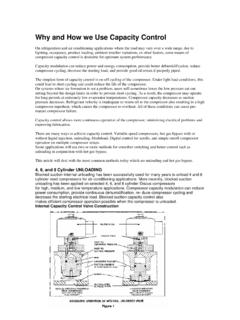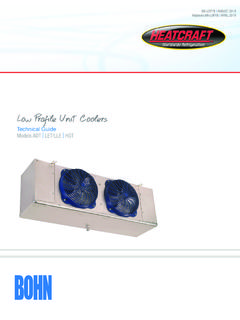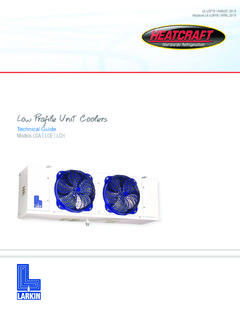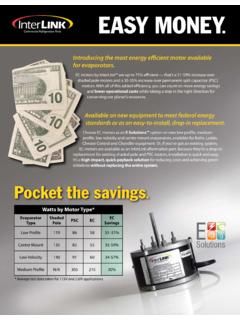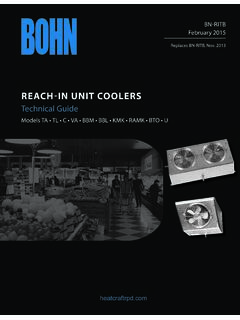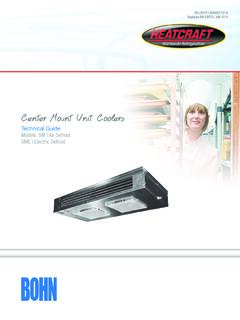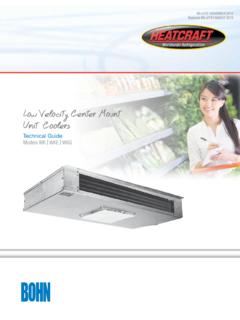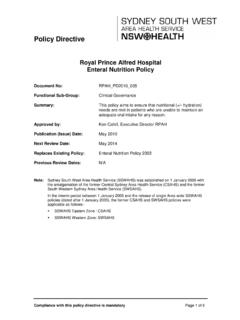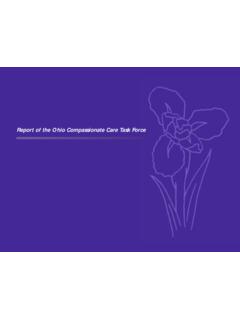Transcription of Tech Topics Refrigerant Distribution
1 tech Topics Refrigerant Distribution The Refrigerant distributor equally distributes Refrigerant flow from the outlet of the Thermal Expansion Valve to each evaporator coil circuit via distributor tubes . A portion of the Refrigerant passing through the Thermal Expansion Valve flashes into a liquid and vapor mixture. This mixture is predominately liquid by weight and vapor by volume. This is referred to as two-phase flow. Once separated, this mixture moves at different velocities since gravity has a greater effect on the heavier liquid portion of the mixture. This is referred to as Slip. To achieve proper Refrigerant mass Distribution , the liquid portion of the liquid, vapor mixture must be divided equally to each evaporator circuit. This is accomplished by maintaining a homogeneous mixture of liquid and vapor until equal portions of the flow are divided into each evaporator circuit.
2 The Distributor Assembly consists of the Distributor Body, Dispersion Cone, Distributor Tubing, Nozzle, and Nozzle Retaining Ring. Sporlan Valve Company Figure 1. The homogeneous mixture (uniform in composition) leaving the thermal expansion valve enters the distributor nozzle. The nozzle increases the velocity of the Refrigerant mixing it's liquid and vapor components. The nozzle is positioned such that flow is directly focused onto the dispersion cone, equally dividing the mixture into evenly spaced passages around the cone. The distributor tubes transports the Refrigerant to each evaporator circuit. The pressure drop across the distributor creates the high velocity necessary to distribute the Refrigerant flow evenly. The pressure drop across the nozzle focuses the flow and provides the necessary liquid, vapor mixture.
3 The pressure drop across the distributor tubes assists in balancing the flow as it enters the distributor passages. As a result, distributor tube and nozzle sizing is critical for proper Distribution . 1. Figure 2 below shows the frosting pattern of an evaporator coil with an improperly sized nozzle. In order to provide uniform feeding, it is important that each evaporator circuit has equal resistance therefore each distributor tube must be of equal length and pressure drop. The distributor tubes should be bent carefully. Sharp bends or kinks reduce the inside diameter of the tube causing increased resistance. Since the distributor equally meters a homogenous mixture of Refrigerant to each evaporator circuit it is equally important that the heat load of each circuit be equal. The lightest load circuit 2. will have the lowest outlet superheat and will affect the control of the expansion valve feed while other heavier loaded circuits will be starved for Refrigerant .
4 This will significantly reduce the evaporator's rated capacity and performance. This is why unobstructed airflow is critical for proper evaporator performance. Proper Refrigerant distributor performance is directly related to compressor performance, expansion valve performance and evaporator performance. Poor Distribution will contribute to expansion valve hunting which can contribute to occasional liquid flood back to the compressor and reduced evaporator capacity. Effects of Liquid Temperature Normally the nozzles and expansion valves are sized for the warmest liquid temperature possible. Normal parameters are 110F condensing and 90F liquid however ambient conditions change which could cause a significant swing in liquid temperature. In other words we have to consider liquid sub-cooling. Liquid sub-cooling is Refrigerant cooled below the saturation point at a given pressure.
5 As we sub-cool liquid Refrigerant , we reduce the level of energy content and create higher potential for the Refrigerant to absorb heat, therefore a lower Mass Flow Rate (Mass Flow Rate is defined as the molecular measurement of the gas flow rate expressed by units of mass per unit of time) is required for sub-cooled 50F liquid than 90F liquid to absorb the same quantity of BTU's. (See Enthalpy and Entropy below). To understand Mass Flow we need to begin with the relationship between volume, temperature and pressure. Refrigerant gas phase roughly follows the Perfect Gas Law, which states that the pressure, temperature, and volume of a gas are all interrelated by: PV = nRT, where: P = Pressure, V = Volume, n = number of molecules or mass expressed in moles, R = Universal gas constant and T = Absolute temperature. The Law defines the volume a certain mass of a gas will occupy at specific conditions.
6 For example, a fixed mass of a gas occupies a one-liter container at 70 F and 1 atmosphere pressure ( PSI). When the pressure of the system is increased, with the temperature held constant, the volume will decrease. If the temperature is increased, with the volume held constant, the pressure will increase. The only constant here is the mass of the gas; it does not change. Enthalpy, also know as the heat content, is a measure of how much heat a gas or liquid can hold. A gas can have the same heat content at different temperatures although other properties such as pressure and volume will vary as we learned from the Perfect Gas Law. Simply put, sub cooled liquid has a greater capacity to absorb heat. Entropy is the ratio of the heat content of a gas to the absolute temperature of a gas. Entropy stays the same when a gas is reversibly compressed provided no external heat is added or removed.
7 In so many words, The Perfect Gas Law, Enthalpy, and Entropy explain why the nominal capacity of the nozzle increases as the liquid temperature decreases. This correlation can be plotted on a Mollier Diagram. These diagrams are Refrigerant specific. Refrigerant specific nozzles supplied with each evaporator coil are sized for a maximum 15F. evaporator TD and 80F liquid temperature. If mechanical sub-cooling is to be used a new nozzle and expansion valve selection will be required to ensure proper Refrigerant Distribution . It is recommended that you consult the factory Application Engineering Department or a representative for distributor nozzle sizing. You will need to know the following: 3. Refrigerant Evaporating Temperature BTU per hour Highest liquid Temperature Compressor or condensing unit capacity Sub Cooling Basically we have three methods under which liquid sub-cooling can occur that we need to consider.
8 Mechanical Sub-Cooling This method of sub-cooling is usually found on rack refrigeration systems where the medium temperature suction group also serves a liquid heat exchanger in order to increase the capacity of the low temperature suction group. Mechanical sub-cooling will provide a constant sub-cooled liquid temperature. Sub-Cooling Circuits and Heat Exchangers This method uses a section of the air-cooled condenser know as the Sub-Cooling Circuit to sub- cool the liquid Refrigerant . In some cases a liquid to vapor heat exchanger is used to sub cool the liquid. These heat exchangers are mounted at the outlet of the evaporator. Ambient Sub-Cooling This refers to a liquid temperature drop due to exposure to the elements or a conditioned space. Avoid running non-insulated liquid lines through conditioned areas or exposed to cold ambient conditions.
9 Sources: The Sporlan Company, Heatcraft H-IM-64F, RSES Article RT-40, Thomas J. Glover Pocket Reference, Flow and Level Handbook and Encyclopedia, Heatcraft Application Engineering_. 4.


